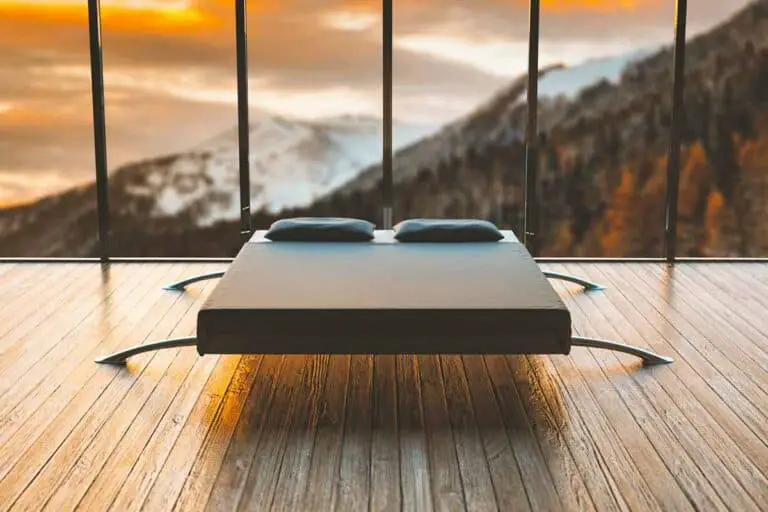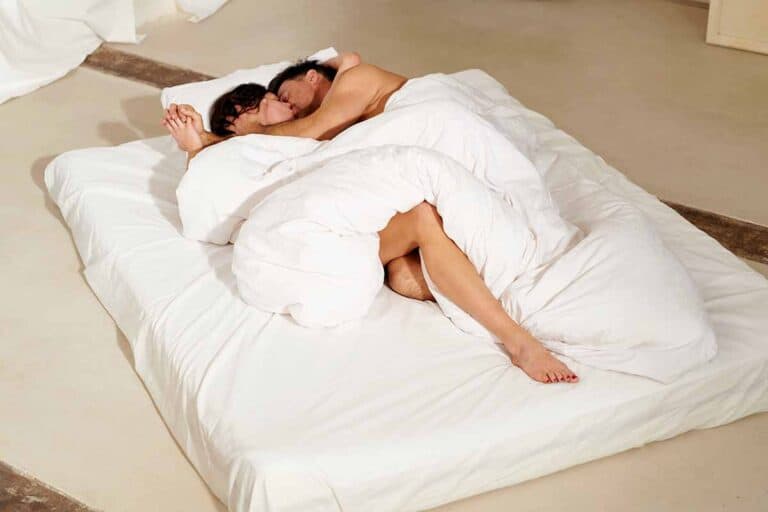A Box Spring for Your Foam Mattress? (Read This First!)
A mattress is essential to a comfortable and refreshing night’s sleep. While you could put your mattress on a floor for reasons of convenience and cost, mattresses work best with bed bases.
A bed base supports a mattress, and a mattress benefits from the best bed base to extend its life and let you benefit from its features.
But is a box spring suitable for you to put your foam mattress on?
A box spring is an older generation bed base, whereas a foam mattress or a memory foam mattress is a newer generation mattress. A box spring is not required and, in most cases, structurally unsuitable for a foam mattress. A newer generation bed base is what you need.
There are generally 5 types of bed bases, and what they are, and their pros and cons, are explained below so you can make the right choice for your foam mattress to protect the warranty and extend its longevity.
Start with the right bed base for your mattress to improve your posture and quality of sleep.
What is the Difference Between a Box Spring and a Mattress Foundation?
The clue is in the name. The traditional mattress support used heavy duty metal springs enclosed in a wooden frame – a box of springs shortened to box spring.
A foundation generally refers to any underlying structure that bears the load of another object placed on it.
On the other hand, a mattress foundation refers to one of the 5 types of bed bases alongside a box spring.
Both a box spring and a mattress foundation provide a form of support for the mattress. The difference lies in the specific way they provide that support. A box spring works in unison with the mattress in absorbing movements from the sleeper, while a mattress foundation provides a flat and rigid surface to prop up the mattress.
As the sleeper lays on the bed, the mattress compresses while the box spring below it does the same but to a lesser extent.
A mattress foundation doesn’t have springs, unlike a box spring. Mattress technology means the mattress reacts to the weight and movements of the body instead of the foundation.
What are the Types of Bed Base?
If you walk around a furniture showroom, you see a vast arrangement of beds, some with slats, some not, headboards and footboards, underdrawers, and other design features.
Regardless of styling, all bed bases are supports for mattresses and fall into one of five different categories.
1. Bed Frame
A bed frame is one of the earlier iterations of structural framing for a bed. It consists of steel rails held together as a rectangular frame, mostly supported by steel glides (vertical members) which function to lift the mattress off the floor surface.
Most of the bed frames come without a headboard or footboard.
A bed frame for smaller mattresses is essentially a bare-looking rectangular steel frame. Meanwhile, a bed frame designed for larger mattresses often has an additional intermediate steel member effectively halving the span and distributing the combined weight of mattress and sleeper the frame needs to carry.
A bed frame alone is insufficient to properly support a mattress. It needs to work together with a separate layer of base such as a box spring that absorbs and distributes the forces to the bed frame and onto the floor.
Pros of a bed frame:
- Straightforward to install in a room and to replace.
- Flexible for small variations in mattress sizes.
- The bedframe is light and easy to move.
- An effective way to elevate the mattress, allowing heat and moisture to dissipate under the mattress.
- Some glides are adjustable thus enabling height adjustment to suit.
- Retractable and easy to move around.
- Low cost.
Cons of a bed frame:
- Requires a box spring in order to properly support the mattress.
- Only suitable for a limited number of mattress types.
- The bare metal frames with long spans can bend and cause the mattress to sag.
2. Box Spring
The traditional box spring, with its bouncy metal springs enclosed in a rigid frame, covered with fabric, is still popular for specific but limited reasons.
A box spring mattress combines with a bed frame to give the perfect base for a double-sided innerspring mattress that needs to flip regularly for even wear on both sides. If you already have an existing bed frame and a new innerspring mattress, getting a box spring is relatively affordable.
On the downside, this combination of a bed frame and a box spring is only suitable for an innerspring mattress.
An all-foam mattress, on the other hand, is designed to take and distribute loads of the sleeper without requiring a bed base to perform that same function.
Furthermore, the springs within the box spring can break, thereby puncturing the underside of the mattress. This will not be obvious to you until you feel unevenness on the mattress or an uncomfortable protruding object beneath the mattress.
By then, the damage has been done.
If you are thinking, “Do I need a box spring with a foam mattress?”, well, the answer is a pretty straightforward no.
However, in the event you have an innerspring mattress but do not have or plan to have a bed frame, then getting a box spring is an affordable way to provide the elevation the mattress needs for hygiene and warranty protection purposes.
Do note though that the height of the bed is determined by the thickness of the box spring and this height is not adjustable.
Pros of a box spring:
- Good for traditional double-sided innerspring mattresses.
- Raises the mattress from the floor for ease of getting in and out of bed, and better hygiene and protection from dust, dirt, and mites.
- Allows heat and moisture to escape underneath the mattress.
- Can also be used on other bed frames with insufficient slats to support innerspring mattresses.
- Relatively lower cost compared to other bed base types.
Cons of a box spring:
- The springs within are subject to breakage that can damage the mattress.
- Only suitable for an innerspring mattress, and other limited arrangements.
- The volume occupied by a box spring is unusable, unlike newer bed base designs that incorporate storage spaces.
3. Mattress Foundation
A mattress foundation is much like a box spring taking on the role of intermediate support between the mattress and the bed frame. It takes point loads from the mattress and distributes it evenly over the bed frame.
You can also look at it as an updated version of the traditional box spring, providing a more contemporary look to suit modern bedrooms.
Unlike a box spring though, a mattress foundation does not contain springs. It a type of foundation typically made from metal or sturdy wood slats and oftentimes covered in breathable fabric.
In simple terms, it is a solid framed box to support the mattress and provide the raised platform to distance the mattress from the floor.
Mattress foundations can also take the form of Bunkie boards – thick plywood boards wrapped in fabric – placed on top of a slatted bed frame.
Pros of a mattress foundation:
- Stronger build compared to a box spring and can support heavier mattresses such as memory foam mattresses and hybrid mattresses.
- The form is compact which does not add unnecessary bulk – fits well with minimalist décor.
- Distributes weight more evenly due to its solid surface.
- Suitable for a wide variety of mattresses.
- Relatively affordable among all types of bed bases.
Cons of a mattress foundation:
- Contains no flex – unsuitable for innerspring mattresses.
- Breakage in any structural support member can result in a whole replacement.
4. Platform Bed Base
A platform bed base is a newer type of bed base that is increasing in popularity. It features a large, sturdy base designed to hold a mattress without other forms of additional support.
In fact, it is designed to completely eliminate the need for a box spring and a bed frame.
The internal structures are made of closely-spaced wood or metal slats and covered in fabric. The slats design and air space underneath it provide the much-needed ventilation for the mattress to breathe and prevent mildew and mold build-up.
For mattresses larger than a single, a central support member is typically introduced to support the added weight and span.
You will find that newer and heavier mattresses such as memory foam mattresses, hybrid mattresses, and pocket spring mattresses are now sold with a matching fully-styled platform bed base.
These platform bases often incorporate a headboard, footboard, and storage compartments for a sleek, multi-use bed base.
The height of the base is not adjustable but is designed for ease of getting in and out of bed for an average height person. Therefore, it is important to be mindful of the combined height of the base and the mattress to ensure it suits you.
Pros of a platform bed base:
- Strong and sturdy – improves the lifespan of a mattress
- Allows airflow beneath the mattress, yet looks fully-encased
- Eliminates other forms of foundational support.
- Can incorporate storage.
- Flexible styling.
Cons of a platform bed base:
- Can get rather expensive with padded and upholstered finishing.
5. Adjustable Bed Base
A hinged sleeping surface adjusts to a slope (between 40 and 70 degrees) with a lever or a motor. Either slats or a solid surface is available depending on preference.
The base is designed with different zones that move independently.
Adding a tilt to portions of the bed gives comfort and a range of health benefits. Swollen legs benefit from elevation, and coming to a semi-seated position is useful for people with mobility or age issues.
Plus, an upright position makes watching TV, reading, or having breakfast in bed more relaxing.
The mattress needs to bend and flex with the movement of the base – a memory foam mattress is ideal, and the thickness needs to be less than 14 inches.
Pros of an adjustable bed base:
- Maximum comfort for promoting healthy, restful sleep by being in the best shape for the individual.
- Two sleepers can have their half adjusted separately.
- Aids mobility.
Cons of an adjustable bed base:
- Expensive – can be built to individual specifications.
- Heavy – extra mechanisms and solid frame mean it is not easy to move around.
- The mattress needs to be soft enough to adjust – restricted mainly to memory foam mattresses or other types of all-foam mattresses.
What Are the Different Types of Foam Mattresses?
There are three standard types of foam mattress:
- Poly Foam
Polyurethane using a combination of the three different grades (high resiliency, high density, and regular) to provide a comfortable, structured mattress.
- Foam Latex
An aerated sap-like material providing bounce and firmness.
- Memory foam
A viscoelastic combination of polyurethane with additives, producing a foam that bounces back to its original shape.
- Gel memory foam
Gel-infused memory foam in the form of a gel layer or gel beads. This type is designed in response to foam mattresses that need to sleep cooler.
Which Is the Best Base for a Foam Mattress?
Most mattresses are a combination of foam layers to produce a mixture of firmness and bounce to suit a range of preferred sleeping styles. Even hybrid mattresses contain layers of foam on top of the layer of springs or pocket springs.
An all-foam mattress can go on any bed base, but some bases provide a better level of support with the exception of a box spring.
Before deciding on a bed base for a new mattress, check the warranty, it may specify the base needed to prolong the mattress life and give you maximum benefits of its features.
Slatted bases – mattress foundation, and platform bed base – provide excellent airflow underneath the mattress. Airflow is vital to remove heat and moisture from the mattress, avoiding potential problems with mold and mildew.
The disadvantage of a slatted base is the gaps between the slats can result in the foam sagging into the gap.
Although the general recommendation is to look for gaps between the slates of less than 3” (76mm), smaller gaps of 2.5” (63mm) to 2” (50mm) are preferable for a slatted bed base as they provide better support for the mattress while still allowing sufficient gaps for ventilation under it.
A slatted platform bed base is best for heavy on-sided foam mattresses such as all-foam, hybrid, and pocket spring mattresses that need rotating but not flipping. This type of bed base provides a balanced combination of design, support, and hygiene considerations. For a cheaper alternative, a mattress foundation will perform just as well structurally.
Summary
Your foam mattress will perform at its best with a stable, firm, and well-ventilated bed base.
All bed bases are a degree compromise between the need for airflow and support. First, check the mattress warranty in case the bed base is specified – if you invest in a high-quality mattress, you want to have full use of the warranty.
After that it is your personal preference, you can put your foam mattress on a:
- Mattress foundation
If you want solid support for the mattress, yet have a simple-looking bed base that is affordable.
- Platform bed base
If you want excellent support for the mattress that provides a reasonable degree of ventilation for the mattress, additional storage under the bed, and do not mind investing more.
- Adjustable bed base
If you desire the ability to adjust the inclination of the bed for comfort and mobility. But check that the mattress and its thickness are compatible with adjustable bases.
Everyone’s needs and preferences suit a different combination of bed base and mattress.
Other FAQs
What is the best base for a memory foam mattress?
Most solidly-constructed bed bases can be paired with a memory foam mattress, with the exception of traditional box springs.
A platform box base made of wood or steel slats constructed less than 3” (76mm) apart is best suited to a memory foam mattress. It provides the necessary mattress elevation for hygiene purposes and ventilation for the mattress to stay cool and dry. The ample structural support ensures that the mattress stays in good condition for longer.
Do I need a box spring with a gel memory foam mattress?
Gel memory foam mattresses have been designed in response to the common complaint that memory foam mattresses can get too warm for comfort.
Although ventilation is necessary under the mattress to help it stay cooler and prevent moisture buildup that could cause mold growth, a box spring is not needed and inappropriate to support a gel-infused memory foam mattress. Go for a slatted box base instead.
Do you need a special bed frame for a memory foam mattress?
The evolution of mattress design has seen the invention of memory foam mattresses improving on the earlier iterations of traditional innerspring mattresses in the way they conform more-readily to the contour of the human body.
They also perform better in evenly distributing the body weight to relieving pressure on the heaviest parts of the body.
A special bed frame, however, is not necessary for a memory foam mattress. Non-spring and solidly-constructed bed bases are commonly and readily available on the market and are more than sufficient to provide the necessary support a foam mattress needs.






